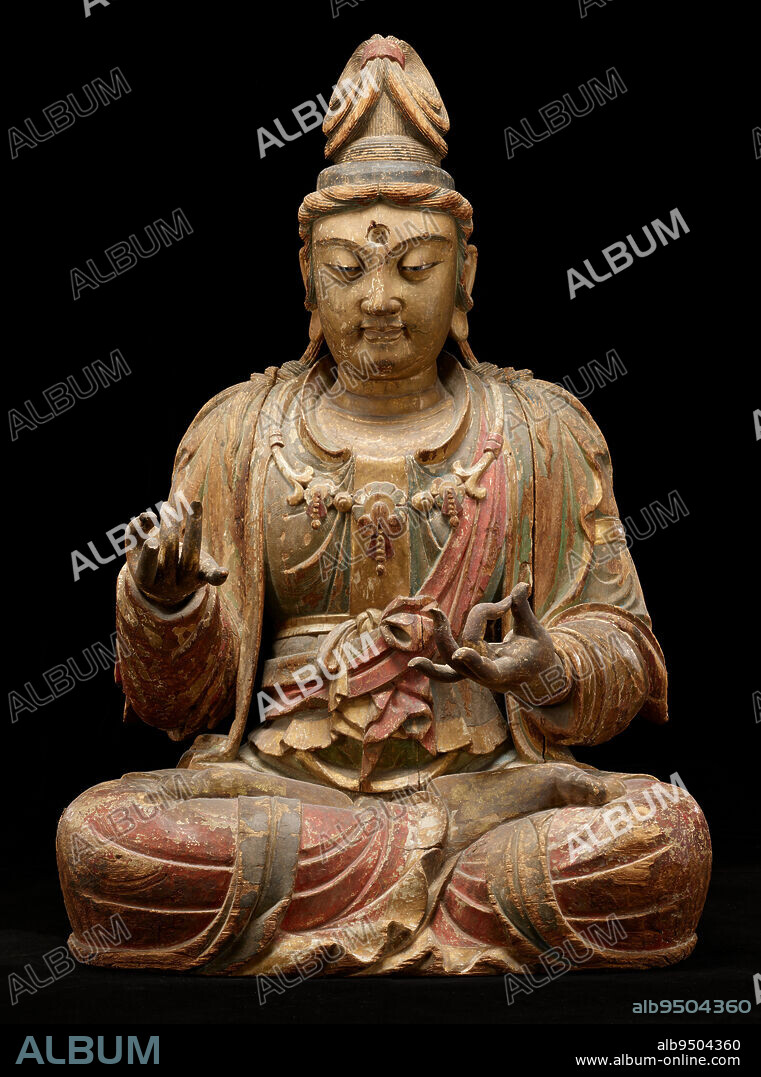alb9504360
Seated Avalokiteshvara Bodhisattva (Guanyin), late 11th-early 12th century, Unknown, 38 3/4 x 22 x 13 1/2 in. (98.43 x 55.88 x 34.29 cm) ((a) body)8 x 30 1/4 x 13 in. (20.32 x 76.84 x 33.02 cm) ((b) legs)25 x 17 x 12 3/4 in. (63.5 x 43.18 x 32.39 cm) ((c) arm)22 1/2 x 19 1/2 x 7 7/8 in. (57.15 x 49.53 x 20 cm) ((d) arm)14 x 14 x 14 1/2 in. (35.56 x 35.56 x 36.83 cm) ((e) PL hip)8 3/4 x 7 1/2 x 5 in. (22.23 x 19.05 x 12.7 cm) ((f) ushnisha)10 3/4 x 5 1/2 x 4 in. (27.31 x 13.97 x 10.16 cm) ((g) hand)11 3/4 x 5 1/2 x 4 in. (29.85 x 13.97 x 10.16 cm) ((h) hand), Wood, gesso, mineral pigments, and gold, China, 11th-12th century, A bodhisattva is a Buddhist deity who has attained the highest level of enlightenment but delays entering paradise in order to aid other earthly beings. Because bodhisattvas remain on earth, their bodies are usually lavishly adorned, unlike buddhas, who have entered the perfected state of nirvana. Here seated in the lotus position, the bodhisattva Avalokiteshvara wears gold jewelry and luxurious silk robes that the artist embellished with delicate designs made of gold foil and gold paint. Originally, his already elaborate topknot would have been further decorated with a gilt-metal crown, although it is now missing. Avalokiteshvara is associated with mercy and compassion. His Chinese name, Guanyin, means 'perceiver of sounds' and is an indication that this merciful being has the ability to recognize all the peoples cries of suffering. These associations help make this figure one of the most popular deities to Chinese Buddhists, who might worship a sculpture like this in the hope that Avalokiteshvara would recognize their suffering and help them on their path toward salvation.

|
Add to another lightbox |
|
Add to another lightbox |



Buy this image.
Select the use:

Caption:
Seated Avalokiteshvara Bodhisattva (Guanyin), late 11th-early 12th century, Unknown, 38 3/4 x 22 x 13 1/2 in. (98.43 x 55.88 x 34.29 cm) ((a) body)8 x 30 1/4 x 13 in. (20.32 x 76.84 x 33.02 cm) ((b) legs)25 x 17 x 12 3/4 in. (63.5 x 43.18 x 32.39 cm) ((c) arm)22 1/2 x 19 1/2 x 7 7/8 in. (57.15 x 49.53 x 20 cm) ((d) arm)14 x 14 x 14 1/2 in. (35.56 x 35.56 x 36.83 cm) ((e) PL hip)8 3/4 x 7 1/2 x 5 in. (22.23 x 19.05 x 12.7 cm) ((f) ushnisha)10 3/4 x 5 1/2 x 4 in. (27.31 x 13.97 x 10.16 cm) ((g) hand)11 3/4 x 5 1/2 x 4 in. (29.85 x 13.97 x 10.16 cm) ((h) hand), Wood, gesso, mineral pigments, and gold, China, 11th-12th century, A bodhisattva is a Buddhist deity who has attained the highest level of enlightenment but delays entering paradise in order to aid other earthly beings. Because bodhisattvas remain on earth, their bodies are usually lavishly adorned, unlike buddhas, who have entered the perfected state of nirvana. Here seated in the lotus position, the bodhisattva Avalokiteshvara wears gold jewelry and luxurious silk robes that the artist embellished with delicate designs made of gold foil and gold paint. Originally, his already elaborate topknot would have been further decorated with a gilt-metal crown, although it is now missing. Avalokiteshvara is associated with mercy and compassion. His Chinese name, Guanyin, means 'perceiver of sounds' and is an indication that this merciful being has the ability to recognize all the peoples cries of suffering. These associations help make this figure one of the most popular deities to Chinese Buddhists, who might worship a sculpture like this in the hope that Avalokiteshvara would recognize their suffering and help them on their path toward salvation.
Credit:
Album / quintlox
Releases:
Model: No - Property: No
Rights questions?
Rights questions?
Image size:
5000 x 6730 px | 96.3 MB
Print size:
42.3 x 57.0 cm | 16.7 x 22.4 in (300 dpi)
Keywords:
A • ABILITY • ALTHOUGH • ANATOMY: LEG • ARM • ARTIST EMBELLISHED • ASSOCIATE • ASSOCIATED • ASSOCIATIONS HELP • AVALOKITESHVARA • B • BODHISATTVA AVALOKITESHVARA WEARS GOLD JEWELRY • BODIES • BODY • BUDDHAS • CADAVER • CAMINO • CHINESE BUDDHISTS • CHINESE NAME • COMPASSION • CORPS • CORPSE • COUNTRY ROAD • D • DEAD BODY • DELICATE DESIGNS • E • EARTH • ELABORATE TOPKNOT • ENTERED • F • FIGURE • FURTHER DECORATED • GILT-METAL CROWN • GOLD FOIL • GOLD PAINT • GUANYIN • HELP • HOPE • INDICATION • LATE 11TH-EARLY 12TH CENTURY • LEG • LEG, ANATOMY • LEGS • LINKED • LOTUS POSITION • LUXURIOUS SILK ROBES • MEANS PERCEIVER • MERCIFUL • MERCY • MIGHT WORSHIP • NIRVANA • NOW MISSING • ORGANS • ORIGINALLY • PATH • PEOPLE'S CRIES • PERFECTED STATE • PITY • PL HIP • POPULAR DEITIES • RECOGNISE • RECOGNIZE • ROAD • ROUTE • SALVATION • SCULPTED • SCULPTING • SCULPTURE • SCULPTURE. • SCULPTURES • SCUPTURE • SEATED AVALOKITESHVARA BODHISATTVA • SEATED • SIT DOWN • SIT • SITS • SITTING • SOUNDS • SUFFERING • USHNISHA • USUALLY LAVISHLY ADORNED • WAY
 Pinterest
Pinterest Twitter
Twitter Facebook
Facebook Copy link
Copy link Email
Email
